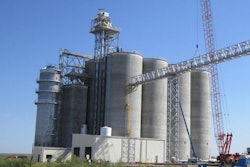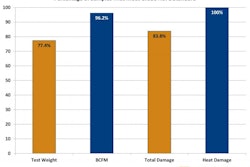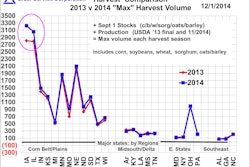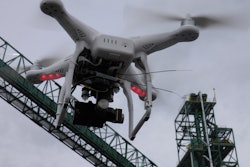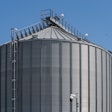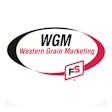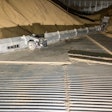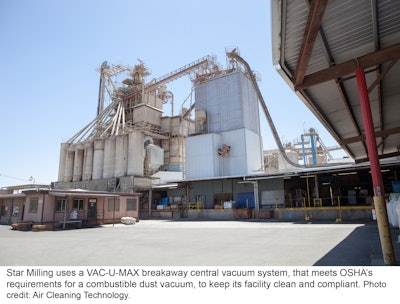
When Missy Morrison, plant manager at Star Milling says, “we want to avoid injury at all costs,” she’s not regurgitating a safety slogan, but stating a legitimate objective. Morrison and Maintenance Manager, Keith Williams, attend several safety seminars throughout the year and devote a significant amount of time staying abreast of OSHA news. “We are in a high risk industry,” says Williams. “Many people don’t understand that grain milling is high risk. It’s an extremely flammable industry.”
Star Milling, in Perris, CA, began as a means to produce quality feed for the family egg farm. The mill brings in raw grains and other ingredients to produce wholesome feed for a wide variety of animals. In addition to producing its feed labels Integrity, Kelley’s, Ace Hi, and Ultra Balance, the company also provides private label services and delivers its feed in bulk tankers to farms. Functioning on the same principles for over 40 years, the feed mill is still family-owned and operated and is the largest feed mill in Southern California.

With increasing production, manual cleaning methods were becoming cumbersome. “As plant manager, the vision for me is a clean mill. I want to look up high and not see any webs or dust,” says Morrison. “I feel that a clean environment makes it easier to be at work and that creates a happier, more productive team.”
Knowing that combustible dust is one of OSHA’s increasingly hot topics, “especially with feed mills,” says maintenance manager Williams, he and Morrison began researching alternatives to manual cleaning methods of sweeping and using compressed air. “Compressed air is the biggest thing to get away from right now,” says Williams, “it just blows the dust around into hard to reach areas.”
Although vacuum cleaners are the preferred method of removing fugitive combustible dust, the mill had previously used an agricultural vacuum which Williams says, “is great on the farm, but not for an application like ours. We tried to use it for years but it just wasn’t working.”
The other alternative was a central vacuum system that Williams says, “would be expensive to set up and require more piping which would increase the areas where dust could settle. Also, this is a big facility, and getting a vacuum that can pull from one end to the other would require something huge and the cost would be crazy. So we had to figure out how to combat an expensive problem cost-effectively.
Traditionally central vacuum systems require a bag house with either a chemical suppression system or an explosion venting system to meet NFPA and OSHA standards.
Both Williams and Morrison remembered reading an article about a VAC-U-MAX breakaway central vacuum system that met OSHA’s requirements for a combustible dust vacuum, so they researched companies that had product lines that fit those requirements.
Celebrating 60 years of intrinsically safe vacuum cleaners for production lines and other dust-intensive areas, Belleville, NJ-based VAC-U-MAX, the pioneer of heavy-duty industrial vacuum cleaning systems, has field proven equipment that creates a safer and cleaner environment for both capital equipment and employees.
After researching available options, Morrison set up meetings with a European industrial vacuum cleaner company, as well as Air Cleaning Technology (ACT) that represents VAC-U-MAX locally.
In the air cleaning business for 37 years, Santa Ana, CA-based ACT is a full-service pollution control company providing consulting, design, engineering, equipment, installation, routine maintenance and around the clock service.
During the initial discussion between ACT’s, Randy O’Halloran, Sales Engineer, and Star Milling, the option of dust collection equipment was considered. However, during the walk-through when O’Halloran witnessed the problem areas the feed mill wanted to handle such as rafters, beams and pits, coupled with their desire to quickly clean spills, O’Halloran says, “when it comes to that type of application it isn’t just collecting fine dust, they’re collecting a little bit of everything and it naturally lead itself to be a vacuum cleaning application.”
After receiving quotes from both companies, Williams created spreadsheets to ensure they were comparing apples to apples, laying out every type of hose, connection; “everything side by side,” says Williams and Morrison in chorus. The price points were pretty close.
When asked what the tipping factor was in choosing the system, Williams said it was difficult to recall all the points that sold him given that 8 months had passed; however there were two points that did come readily to him. “The VAC-U-MAX 1020 has much higher suction and that made me happy; and, the European brand was metric and I prefer to keep everything in the shop standard if I can.”
The cause for the higher suction on the USA model is a result of the positive displacement pump (PD pump) vacuum producer. PD pumps are capable of generating high vacuum and excellent airflow so they have the ability to pull massive amounts of material over distances. The 15HP model that the feed mill employs can move 10,000 lbs of powder in an hour from 30ft away if needed.
Some manufacturers use regenerative blowers as a vacuum source in central vacuum systems which have the airflow but not the simultaneous vacuum. Regenerative blowers look appealing because they show a lot of airflow for a given horsepower, but they do not generate enough vacuum to move material over distances in tubing; when vacuum pressure goes up, i.e. when the job gets harder, performance is lost.
Williams says, “I like the ability to do whatever I want with one vacuum. It is a dual-purpose machine that maximizes ROI. It is a cost effective alternative to what could have been very expensive.”
VAC-U-MAX focuses on selling the right tool for the right job, often discussing the creation of a breakaway vacuum system with several smaller tubing networks. For instance if a user is working in a 100 x 200 sq foot area and there are two more areas in another building, individual tubing networks are created and the 1020 used to break away from one tubing network, rolling to the next network, and so on and so forth.
A typical stationary central vacuum system to suit Star Milling’s plant layout would be much larger and would have required an explosion protection system. The larger size and explosion protection would probably have lead to an outdoor installation, which brings other challenges such as air permits as well as construction permits. The breakaway system avoids those costs and delays, providing the convenience of a multi-inlet central vac, with the energy efficiency and flexibility of a portable vacuum.
Star Milling installed several fixed tubing networks itself. “I have two fabricators, on-staff electricians and programmers—we only bring in contractors for very large jobs. Randy from ACT told me how to do it, sent me diagrams, and told me where to get the pipe and that was that.”

Once the system was in place, a training program was set up to teach supervisors and operators how to use the machine. “It’s pretty much plug and play right away, but the suction is powerful and we wanted to be sure everyone was using the vacuum safely,” says Williams.
“我们确实有一点的学习曲线tercept drum before we got it to the mill,” he says. “We kept collapsing drums and turning them into perfect triangles. I had to call ACT to make sure we were using the system correctly and find out why it was out-performing what we talked about.” Intercept drums need to be a minimum of 16-gauge steel with a rolled-top rim, two reinforcing chines and no dents or dings.
VAC-U-MAX sells drums, but since Star Milling had a wealth of drums on site, they decided to use one they already had and Williams just had to find the right one.
Cleaning the upper area of the Pellet Mill was one of Morrison’s first projects. “Before we purchased the vacuum, we used to clean that area every three months and it took one person all day to clean it,” she says. The area was difficult to clean because it’s elevated and tough to reach everything. The job was messy, requiring knocking everything to ground level and then cleaning from there, which “of course, created dust and it landed where it landed,” she says.
“With the vacuum all the dust and cobwebs are getting sucked into the vacuum system and not spreading anywhere,” says Morrison. “Now we are working on a detailed cleaning of the entire facility, which if you can imagine, would be like cleaning every inch of a large wooden roller coaster. There are lots of high rafters, pipes, ledges, beams and equipment.”
Currently they utilize a crew of 3 workers for 8 hours during the weekend for this task. “After we get there, we’ll have a better understanding if we’ll need someone full time to vacuum or if the operators can do it during their shift rotating days for different areas,” says Morrison.
最大的一个好处和redu最快的成本ctions came with cleaning the elevator pits which are confined spaces. Dust tends to accumulate in the pits “because it’s hidden and you have to go looking for it,” she says. “Now that we have the vacuum we use extension tubes and they give us the ability to get into the confined space without anyone actually having to enter the confined space, which is a big deal for us because every time you have to enter the confined space you need to have a three person team monitor the air,” says Morrison.
Williams adds, “and the extensions don’t reduce the suction of the vacuum.”
Before Morrison and Williams had a chance to set up a schedule to clean the pits, the operators in the area began doing it on their own—getting the vacuum from the shop and bringing it to their area. The unit is designed for one-person maneuverability with 14”diameter wheels, but Star Milling chooses to move the vacuum from area to area with a forklift.
Because the 1020 filter separator and collector are less than 8 cu ft, it does not need an explosion vent to use it in Class II, Div 1 & 2 areas, per NFPA standards and OSHA regulations. Even so, Williams has set up the tubing network so the machine operates in a non-dusty environment. “I just prefer it that way,” he says.
When you combine VAC-U-MAX’s 60 years of experience in vacuum systems and ACT’s 35 years in pollution applications, there is much experience with which to design a system that is custom to a facility’s unique requirements.
Click hereto contact or learn more about VAC-U-MAX vacuum cleaning solutions.





